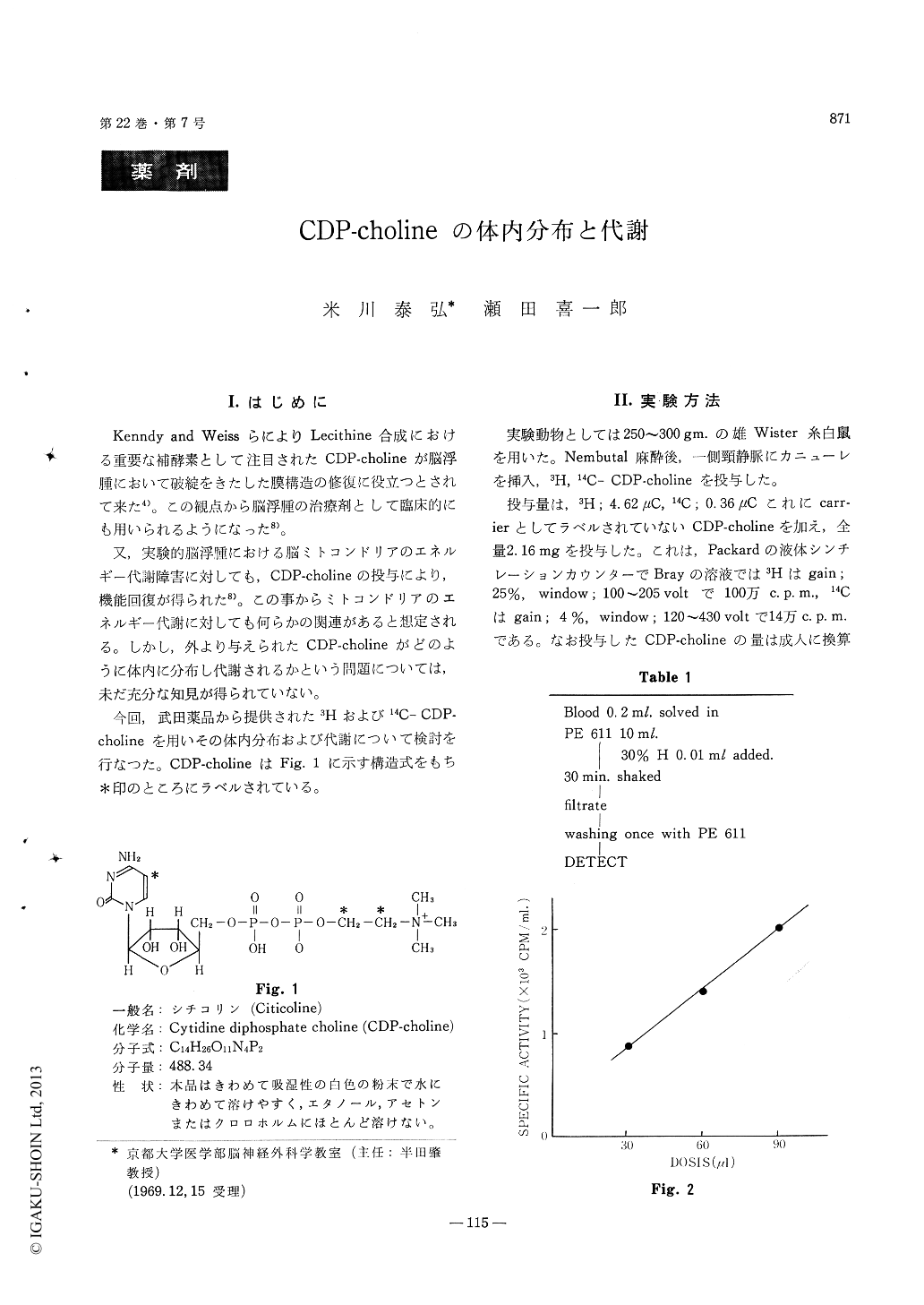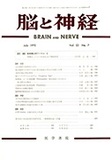Japanese
English
- 有料閲覧
- Abstract 文献概要
- 1ページ目 Look Inside
1)血中濃度は30分以内に投与直後の1/3に減少し,1〜2時間でspecific activityはほゞ一定の値を示す。
2)各臓器へのとりこみでは,腎臓には早期に多量のradioactivityを示し,これは与えられたものが,大分部そのまゝ尿に移行するためと思われる。肺,肝,脾等では2時間後に投与当初の1/2値を示す。
3)CDP-cholineは正常の脳血液関門を通過し難い。また一度通過したものは,排山され難い。Klatzoのco-ld injuryでは正常の脳よりも,とりこみが増す。
4)尿に排出されるものは大部分CDP-cholineがそのま、の形で排出される。
5)大槽内投与は,尿中への排出も緩慢で,臨床的に有用であると思われる。
The work of Kennedy and Weiss has shown that CDP-choline is an important precursor of lecithine. The nucleotide has been reported to be effective for the restoration of the damaged membraneous structures due to cerebral edema. This is also effi-cient for the disturbance of energy metabolism in the rat brain mitochondria due to experimental cerebral edema.
This paper reports the distribution and some met-abolic aspects of CDP-choline after parenteral ad-ministration of the nucleotide labeled with H3 and C14.
Male Wister strain rats weighing 250-300 gm were used, and labeled CDP-choline was administered through jugular vein or via cisterna magna under the anesthesia with Nembutal.
Radioactivities were detected with Packard's liquid scintillation counter. Radioactivities of organs were measured on the acid soluble fraction of the organs after Hurlbert's method. The Bray's solution was used as scintillater. Blood were treated after the Houtman's method and Hurlbert's method.
1) The specific activity of blood decreases about one-third of the value measured immediately after the administration within 30 minutes and then becoms constant in 1-2 hours. Excretion into urine is mostly carried out within 2 hours.
2) The high specific activity can be observed on the kidney in early stage. This phenomenon may be brought about in accordance with urinal excretion. Activities of the lung and liver show remarkable decrease within 2 hours, and afterwards diminish gradually. 2 hours later, the specific ac-tivities of various organs except brain decrease a half of the value measured immediately after the administration.
3) The incorporation into brain is scanty and sluggish in comparison with other organs. CDP-choline has the same character with other nude-stides which are difficult to pass through the blood brain barrier.
4) When given via cisterna magna, the incor-poration into brain shows within an hour maximum value which amounts to 10% of administered dosis. Then it reveals within 2-6 hours relatively cons-tant values which come to 50% of the maximum. Blood concentration reaches maximum within 2 hours, and urinal excretion is almost carried out within 3 hours. These data show the effectivenessof subarachnoid administration of CDP-choline.
5) Column-chromatography was performed on the acid soluble fraction of the urine, kidney and liver removed 2 hours later after administration of the drug.
The elution pattern of urine is almost the same with the kidney, that is, it may be said that ad-ministered CDP-choline is mostly excreted unmet-abolized, which was confirmed with the peak of radioactivity that coincided with the peak of UV absorption with 260 mμ.
The liver reveals a slightly different elutionpattern from the kidney and urine.
6) Cold injury was made on the rat after the method of Klatzo. In accordance with his histo-chemical findings, the incorporation of CDP-choline increased on the brain with cold injury edema as compared with normal brain : It may be said that once blood brain barrier is injured the nucleotide can get through the barrier, then be able to par-ticipate in the restoration of the damaged membrane system.

Copyright © 1970, Igaku-Shoin Ltd. All rights reserved.


